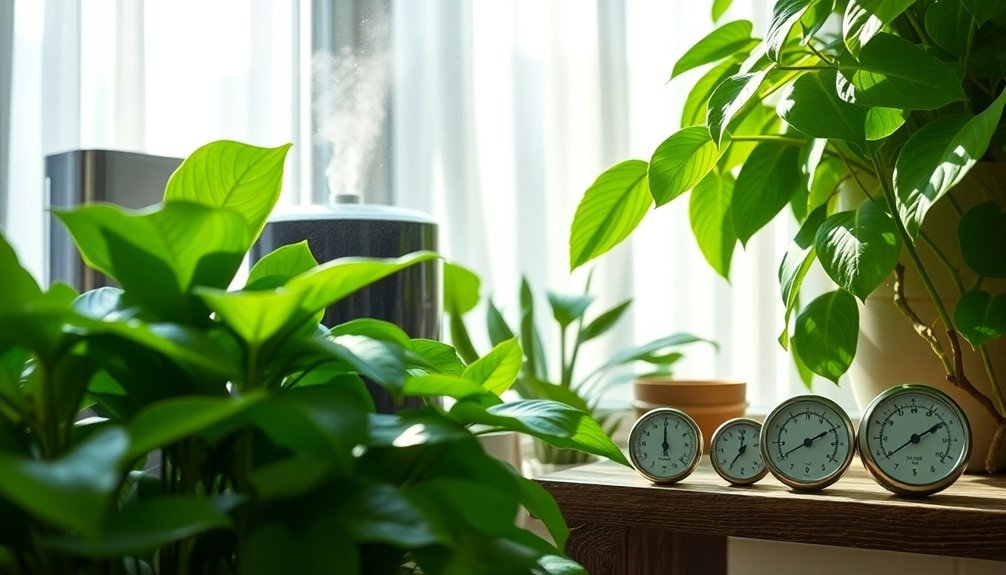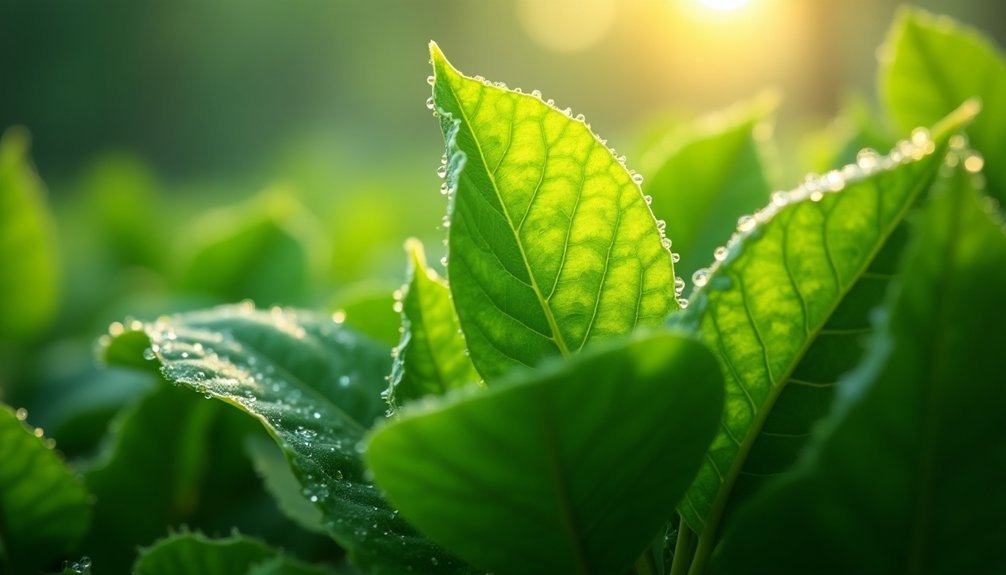Keep your indoor plants thriving by maintaining proper humidity levels between 40-80%. You'll want to mist tropical plants daily, use pebble trays for steady moisture, and group plants together to create humidity-sharing zones. Monitor conditions with a hygrometer and watch for warning signs like crispy leaf edges or drooping stems. If you're struggling with dry air, a quality humidifier can transform your space into a moisture-rich plant paradise.
Understanding Plant Humidity Requirements

While many indoor gardeners focus primarily on watering and light, understanding your plants' humidity requirements is equally essential for their survival. Most indoor plants thrive when humidity levels stay between 40% and 60%, though tropical varieties need even higher moisture levels to flourish.
You'll notice that plants with thin leaves are particularly sensitive to humidity, while those with thick, leathery foliage can better tolerate dry air. If you're growing demanding plants like orchids or gardenias, you'll want to maintain humidity between 60% and 80%.
To increase humidity levels around your plants, try clustering them together, setting up pebble trays, or using a humidifier. Don't forget to monitor the air moisture regularly with a hygrometer – it's your best tool for ensuring your plants get the humid environment they need.
Natural Methods to Boost Indoor Humidity
Now that you understand your plants' humidity needs, several natural methods can help maintain ideal moisture levels in your home. You'll find that daily misting, creating pebble trays, and using a humidifier can help your indoor plants thrive. Group plants together to create a moisture-sharing microenvironment that naturally raise humidity levels.
| Method | Benefits | Best For |
|---|---|---|
| Misting | Direct leaf moisture | Tropical plants |
| Pebble Trays | Steady evaporation | Small spaces |
| Plant Grouping | Shared humidity | All plants |
| Room Placement | Natural moisture | Bathrooms/Kitchens |
Consider placing humidity-loving plants in your kitchen or bathroom, where they'll benefit from naturally higher moisture levels. These simple techniques work together to create the perfect environment for your leafy companions, ensuring they remain vibrant and healthy throughout the year.
Essential Tools for Humidity Management

Successfully managing your plants' humidity requires a core set of reliable tools. Start with a hygrometer to accurately measure humidity levels in your growing space, ensuring you'll know exactly when adjustments are needed.
Invest in a quality humidifier to maintain consistent moisture in dry environments, benefiting both your plants and your own well-being.
Create pebble trays using household containers and LECA stones, which will provide steady humidity through evaporation while preventing root rot.
Don't forget to include misting bottles in your toolkit – they're perfect for direct leaf moisture application, especially for tropical varieties that need extra humidity.
Signs of Humidity-Related Plant Stress
Your first sign of humidity stress often appears in the leaves, where you'll notice crispy edges, yellowing tips, or curling foliage.
Root problems can develop as plants struggle to maintain moisture balance, leading to stunted growth and weak stems.
You might also spot slower overall growth, dropped flower buds, and withering new shoots – all clear indicators that your plant needs more humidity.
Identifying Leaf Damage
Three telltale signs can help you spot humidity-related stress in your plants before serious damage occurs.
First, watch for leaves turning brown or yellowing at the edges, which clearly indicates your plant isn't getting enough moisture from the air. When humidity around the plants drops too low, you'll notice crispy, dry foliage that becomes brittle to the touch.
Second, pay attention to drooping or wilted stems and leaves, as they're struggling to maintain proper hydration in dry air.
Third, if you see flower buds falling off or blooms dropping prematurely, your plant's likely experiencing poor growth due to insufficient humidity.
To prevent these issues, keep your humidity levels between 40-60% and monitor your plants regularly for these warning signs.
Understanding Root Impact
While leaf damage provides visible signs of humidity stress, the impact on a plant's root system can be equally telling.
When plants need to compensate for low humidity, they'll often increase water uptake through their roots, which can lead to overwatering issues if you don't adjust your care routine.
You'll need to carefully balance watering practices with humidity levels. In environments without high humidity, you may notice plants drawing more water from their soil, potentially creating conditions favorable for root rot.
To prevent this, reduce watering frequency while monitoring moisture levels. Watch for signs that your plant is struggling to maintain proper hydration, such as wilting despite moist soil. This indicates your plant's trying to cope with humidity stress through its root system.
Spotting Growth Problems
Maintaining proper humidity levels is essential for healthy plant growth, and recognizing stress signals early can prevent long-term damage.
You'll notice several warning signs when your plants struggle with low humidity. Watch for crispy, dry foliage and leaves with brown or yellow edges – these are clear indicators that your plants need more moisture in the air.
If you spot wilted stems or drooping leaves, your plants are likely experiencing dehydration due to insufficient humidity. Pay attention to flower health too, as plants might drop buds prematurely when humidity levels aren't ideal.
To protect your plants' growth, keep humidity levels between 40-60%. Regular monitoring helps you catch these issues before they become severe, allowing you to adjust conditions quickly and maintain vibrant, healthy plants.
Creating Moisture-Rich Plant Zones
Since moisture-loving plants thrive in humid environments, creating dedicated moisture-rich zones can greatly boost their health and growth.
You'll find that clustering plants together naturally increases humidity levels as they release moisture collectively, forming a beneficial micro-climate.
To enhance these moisture-rich zones, place pebble-filled humidity trays beneath your plant groupings. The water in these trays will evaporate steadily, maintaining consistent moisture levels without risking root rot.
Humidity trays filled with pebbles offer a natural way to boost moisture around plants while preventing waterlogged roots.
Consider relocating humidity-loving varieties like ferns and peace lilies to naturally damp spaces such as bathrooms and kitchens. During dry periods, especially winter months, regularly mist plants to provide immediate leaf hydration.
For an extra boost, position a humidifier near your plant clusters – it's an effective way to maintain ideal moisture levels throughout your indoor growing space.
Seasonal Humidity Adjustments

Just as plants adapt to nature's rhythm, your indoor humidity care must shift with the seasons.
You'll need to monitor humidity levels consistently using a hygrometer to maintain ideal conditions for your leafy companions throughout the year.
Here's how to adjust your plant care across seasons:
- Winter: Group plants together to create moisture-rich microclimates when indoor air becomes dry.
- Spring: Gradually shift plants outdoors while protecting them from sudden humidity changes.
- Summer: Add pebble trays or humidifiers to combat increased evaporation from higher temperatures.
- Fall: Begin preparing indoor groupings as you bring plants back inside.
Smart Solutions for Dry Air Problems
You'll know it's time to boost humidity when your plants show crispy brown edges and drooping leaves, signaling dry air distress.
Take control by misting your plants each morning, setting up pebble trays, or running a humidifier to maintain ideal moisture levels between 40-60%.
For a natural approach, try clustering your moisture-loving plants together and monitor their progress with a hygrometer to guarantee your humidity-boosting efforts are working effectively.
Humidity Control Made Simple
While maintaining proper humidity levels might seem challenging, controlling moisture in your home environment doesn't have to be complicated.
You'll find that simple strategies can make a significant difference in your plants' health and appearance.
Here's what you can do to maintain ideal humidity levels between 40% and 60%:
- Start with regular misting of your plants daily or every few days, especially during dry winter months.
- Place pebble trays filled with water beneath your plants to create moisture-rich microclimates.
- Try grouping plants together to create natural humidity zones through shared transpiration.
- Invest in a humidifier for consistent moisture control, which benefits both your plants and your health.
These straightforward methods will help prevent common issues like curled leaves and dry tips while promoting vibrant, healthy growth.
Natural Moisture Boosting Methods
Natural solutions for boosting moisture levels can transform your dry indoor environment into a plant paradise without breaking the bank.
You'll find several effective methods to create the perfect humid atmosphere your plants crave.
Start by misting your plants with a spray bottle each morning, focusing on the leaves to slow down water loss through transpiration.
Create strategic plant groupings to naturally increase humidity levels as they release moisture into the air.
For an easy fix, set up a pebble tray beneath your plants – as the water evaporates, it'll create a humid microclimate they'll love.
Take advantage of your home's naturally humid spaces by placing moisture-loving varieties in bathrooms and kitchens.
These simple techniques work together to maintain the ideal 40-60% humidity range your plants need to thrive.
Quick Dry-Air Warning Signs
Spotting dry-air warning signs early can prevent serious damage to your indoor plants. When low humidity strikes, your plants will quickly show their distress through visible symptoms that you can't ignore.
Watch for these telltale signs of dry air affecting your plants:
- Crispy, dry foliage with yellowing edges, particularly on new growth.
- Sudden wilting despite proper watering schedules.
- Brown leaf tips and edges that feel brittle to the touch.
- Stunted or slow plant development.
Don't wait until you see these symptoms worsen. Take action by increasing humidity through regular misting, creating beneficial plant groupings, or setting up pebble trays.
Frequently Asked Questions
What Plant Removes 78% of Airborne Mold?
The Peace Lily's your go-to plant for fighting airborne mold, as it'll remove up to 78% of mold spores. You'll want to keep it well-watered and maintain proper humidity for best results.
Is 70% Humidity Too High for Plants?
No, 70% humidity isn't too high for most houseplants. You'll find that tropical plants actually thrive at this level. However, you should keep succulents and cacti in lower humidity, as they prefer drier conditions.
How Does Humidity Affect Leaves?
Humidity directly affects your plant's leaves by controlling moisture loss. You'll notice healthier leaves in proper humidity (60-80%), while low humidity can cause browning edges and wilting as leaves lose too much water.
How Can I Make My Houseplants' Leaves Shiny?
You can make your houseplants' leaves shine by wiping them with a damp cloth, using diluted vegetable oil, applying commercial leaf shine products, or regular misting. Don't treat hairy leaves or expose treated plants to direct sunlight.
In Summary
Keep your plants thriving by staying attentive to their humidity needs. You'll see the difference when you combine natural methods with the right tools and regular monitoring. Don't forget to adjust your approach as seasons change, and remember that each plant has unique moisture requirements. Whether you're using humidity trays, grouping plants, or running a humidifier, you're now equipped to maintain that perfect moisture balance.





Leave a Reply